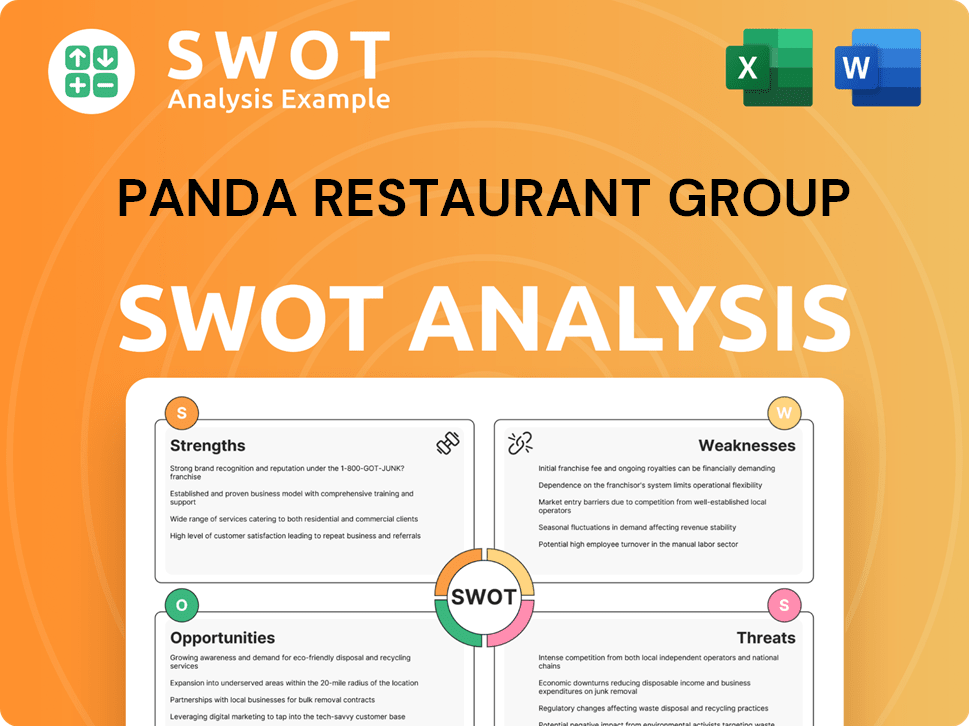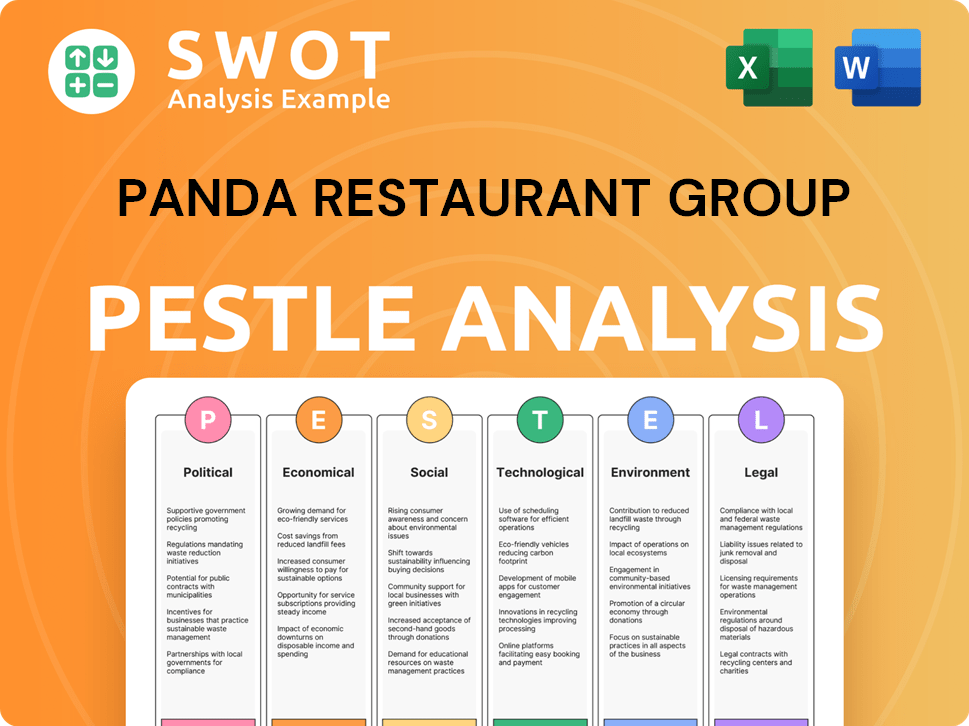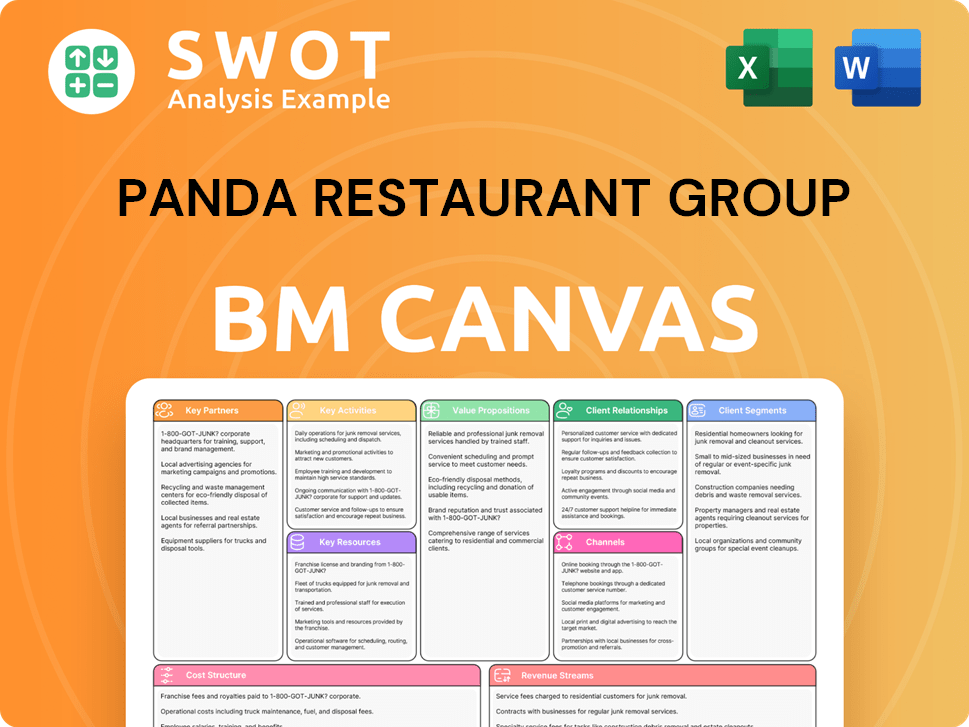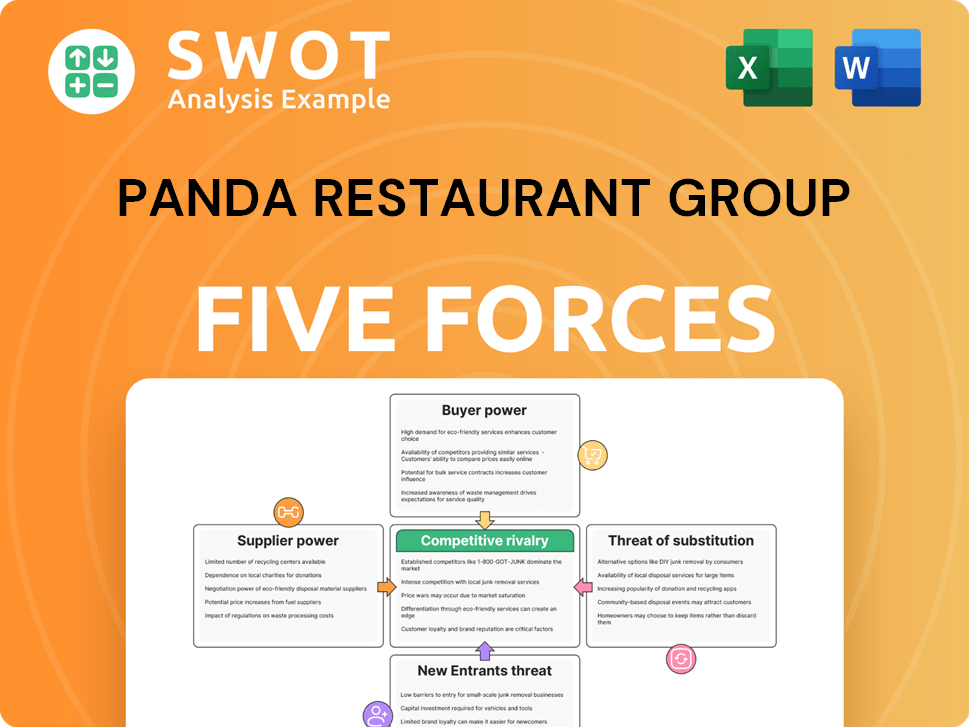Panda Restaurant Group Bundle
Can Panda Restaurant Group Maintain Its Dominance?
Panda Restaurant Group, the powerhouse behind Panda Express, has revolutionized the American Chinese fast-casual dining scene. From its inception in 1973, the company has grown into a global phenomenon, serving millions annually. But what does the future hold for this industry leader?

This analysis will explore the Panda Restaurant Group SWOT Analysis to dissect its growth strategy and future prospects. We'll examine Panda Express's expansion plans, market share, and financial performance within the competitive restaurant industry. Furthermore, we'll delve into how Panda Express adapts to changing consumer trends and its business development strategies to maintain its position.
How Is Panda Restaurant Group Expanding Its Reach?
The Panda Restaurant Group's Growth Strategy heavily emphasizes expanding its physical presence and exploring new markets. This approach is central to its long-term success in the Restaurant Industry. The company strategically targets high-traffic areas to increase accessibility and market penetration, both domestically and internationally.
Panda Express continues to seek new locations in the U.S., focusing on areas like airports, universities, and shopping centers. Simultaneously, the company is actively pursuing international expansion in key global markets. This dual approach allows for diversification of revenue streams and access to new customer bases, crucial for sustained Business Development.
The company's expansion strategy includes a focus on the Philippines, with more openings planned in 2024. Additionally, there's ongoing expansion in the Washington D.C. area and the United Kingdom, with a new store opening in Cardiff in April 2024. These initiatives demonstrate Panda Express's commitment to both domestic and international growth, reflecting its dynamic Growth Strategy.
Panda Express continues to open new locations across the U.S., targeting high-traffic areas. This includes airports, universities, and shopping centers. The company's domestic growth strategy is focused on increasing accessibility and market penetration within the U.S. market.
Panda Restaurant Group is actively expanding its global footprint. Key markets include Canada, Mexico, Dubai, and South Korea. The company is continuously evaluating new countries for entry, aiming to diversify revenue streams and reach new customer bases.
The Panda Express is expanding in the Philippines with more openings planned in 2024. Expansion in the Washington D.C. area is also underway. The United Kingdom is another focus, with a new store opening in Cardiff in April 2024.
The company focuses on strategic locations like airports, universities, and shopping centers. This strategy enhances brand visibility and accessibility. These locations are chosen to maximize customer reach and sales potential.
Panda Express's expansion strategy is a key component of its overall Growth Strategy. The company's ability to adapt to changing consumer trends and maintain its competitive edge is crucial for its long-term success. For more details on how Panda Restaurant Group generates revenue, check out Revenue Streams & Business Model of Panda Restaurant Group.
Panda Express's future goals include continued expansion both domestically and internationally. The company is expected to maintain its growth trajectory by opening new locations strategically. This includes exploring new markets and adapting to changing consumer preferences.
- Continued U.S. expansion with a focus on high-traffic areas.
- International growth in key markets like the Philippines and the United Kingdom.
- Ongoing evaluation of new countries for future expansion.
- Adaptation to changing consumer trends and preferences.
Panda Restaurant Group SWOT Analysis
- Complete SWOT Breakdown
- Fully Customizable
- Editable in Excel & Word
- Professional Formatting
- Investor-Ready Format

How Does Panda Restaurant Group Invest in Innovation?
Panda Restaurant Group, including Panda Express, strategically uses innovation and technology to enhance customer experience and streamline operations. This approach is crucial for its growth strategy within the competitive restaurant industry. The company focuses on adapting to evolving consumer preferences for convenience and efficiency, which is a key element of its business development.
The company has invested in digital transformation, including online ordering platforms and mobile applications. These digital channels not only facilitate order placement but also provide valuable data for personalized marketing and menu optimization. This digital-first experience is a significant part of how Panda Express aims to maintain and grow its market share.
Panda Express continuously innovates its menu offerings, introducing new dishes and limited-time promotions. This strategy helps keep its offerings fresh and appealing, catering to diverse tastes and preferences. The company also utilizes technology for supply chain management and operational efficiency within its kitchens. For more insights into the company's structure, explore Owners & Shareholders of Panda Restaurant Group.
Panda Express has invested heavily in digital platforms for online ordering and mobile applications. These platforms provide convenience and gather data for targeted marketing. This focus is crucial for adapting to changing consumer trends and maintaining customer satisfaction.
The company regularly introduces new menu items and limited-time offers to keep its offerings fresh. This strategy helps attract and retain customers. Menu innovation is a key aspect of Panda Express's growth strategy.
Panda Express uses technology to improve supply chain management and kitchen operations. This helps streamline processes and reduce costs. Operational efficiency is a critical factor in the company's financial performance.
Digital platforms provide valuable data for personalized marketing efforts. This allows Panda Express to tailor its promotions and offers to specific customer preferences. Data-driven marketing enhances customer engagement.
Technology is used to optimize the supply chain, ensuring efficient delivery of ingredients and reducing waste. Effective supply chain management supports operational efficiency. This is a key area for cost control.
The integration of technology aims to improve the overall customer experience. This includes faster ordering, convenient payment options, and personalized service. Customer satisfaction is a key metric for Panda Express.
Panda Express focuses on digital transformation, menu innovation, and operational efficiency. These initiatives are crucial for its growth strategy. The company's approach to technology is integral to its business model.
- Digital Platforms: Online ordering, mobile apps, and digital marketing.
- Menu Innovation: New dishes, limited-time offers, and adapting to regional tastes.
- Operational Efficiency: Supply chain management and kitchen automation.
- Data Analytics: Using data to personalize marketing and optimize menus.
- Customer Experience: Improving ordering, payment, and service through technology.
Panda Restaurant Group PESTLE Analysis
- Covers All 6 PESTLE Categories
- No Research Needed – Save Hours of Work
- Built by Experts, Trusted by Consultants
- Instant Download, Ready to Use
- 100% Editable, Fully Customizable

What Is Panda Restaurant Group’s Growth Forecast?
As a privately held entity, detailed financial disclosures for Panda Restaurant Group are not publicly available. However, the company's substantial presence in the Restaurant Industry and consistent expansion indicate a robust financial standing. Panda Express, the company's flagship brand, is a major player in the quick-service restaurant sector, generating billions in annual revenue.
The sustained growth of Panda Express, both domestically and internationally, suggests strong financial health. This allows for continued investment in new locations and market exploration. The company's ability to adapt to changing consumer trends and maintain operational efficiency further supports its positive financial outlook.
While specific financial targets for 2024-2025 are not publicly released, the historical performance and ongoing growth trajectory of Panda Express suggest a positive financial outlook. The focus on customer experience and operational efficiency contributes to long-term value creation, supporting the company's Growth Strategy.
Panda Express generates billions in annual revenue. This financial performance underscores its significant market share within the fast-casual dining sector. The company's consistent financial success allows for ongoing investment in Business Development.
The ability to open new locations and explore new markets reflects healthy profit margins and capital for reinvestment. Panda Express's expansion plans include both domestic and international growth initiatives. This expansion is a key component of its Growth Strategy.
Focus on operational efficiency supports a strong financial narrative. Streamlined operations contribute to higher profitability and support long-term value creation. This efficiency is crucial for sustaining Panda Restaurant Group's financial health.
Prioritizing customer experience enhances brand loyalty and drives repeat business. Positive customer experiences contribute to revenue growth and support a strong financial outlook. This focus is essential for long-term financial success.
Key performance indicators (KPIs) for Panda Express likely include same-store sales growth, average transaction value, and customer satisfaction scores. These metrics help assess the effectiveness of the company's Growth Strategy.
A thorough Market Analysis reveals opportunities for expansion and areas for improvement. Understanding consumer preferences and competitive dynamics is crucial for sustained financial success. This analysis informs strategic decisions.
The competitive landscape includes other fast-casual and quick-service restaurants. Panda Express differentiates itself through its menu offerings, customer service, and operational efficiency. This differentiation supports its financial performance.
Future goals likely include continued expansion, menu innovation, and enhanced customer experience. These goals are aimed at sustaining and improving financial performance. These initiatives reflect the company's long-term vision.
Franchising can provide another avenue for growth and revenue generation. Franchising allows for rapid expansion while sharing the financial burden. This strategy can increase brand presence.
Sustainability initiatives can enhance brand image and appeal to environmentally conscious consumers. These initiatives can also improve operational efficiency. This approach can contribute to long-term financial health.
Panda Restaurant Group Business Model Canvas
- Complete 9-Block Business Model Canvas
- Effortlessly Communicate Your Business Strategy
- Investor-Ready BMC Format
- 100% Editable and Customizable
- Clear and Structured Layout

What Risks Could Slow Panda Restaurant Group’s Growth?
The Panda Restaurant Group faces several significant risks as it pursues its growth strategy. The restaurant industry is highly competitive, and the company must continually adapt to maintain its market position. Furthermore, external factors such as regulatory changes and supply chain vulnerabilities pose ongoing challenges.
Market competition remains a primary concern for Panda Restaurant Group, particularly within the fast-casual dining sector. The company's expansion plans and financial performance are directly impacted by its ability to differentiate itself from competitors offering similar cuisines. This necessitates continuous innovation in menu items and marketing strategies.
Operational risks, including maintaining consistent food quality and customer service across a growing number of locations, also present significant challenges. Successfully managing these risks is critical to Panda Restaurant Group's future goals and overall business development.
The fast-casual dining landscape is highly competitive, with numerous restaurants vying for market share. Competitors offering similar cuisines or alternative quick-service options can limit Panda Express's market share and profitability. Constant innovation in menu items and marketing is crucial.
Changes in food safety regulations, labor laws, and international trade policies pose potential obstacles. The restaurant industry is susceptible to these changes, requiring constant adaptation and compliance. This can increase operational costs and complexity.
Fluctuations in food costs, ingredient availability, and logistical disruptions impact operational efficiency and profit margins. Panda Express must diversify its sourcing and manage its supply chain effectively. External factors, such as geopolitical events, can exacerbate these issues.
Geopolitical tensions and economic downturns in key international markets can affect expansion plans and consumer spending. The company must assess and mitigate these risks through careful market analysis and strategic planning. Economic instability can reduce consumer demand.
Maintaining consistent food quality and customer service across a vast and growing number of locations is an ongoing operational challenge. Employee training, quality control measures, and efficient management are essential. This can impact customer satisfaction.
Increasing consumer demand for sustainable and ethically sourced ingredients requires ongoing adaptation of supply chain practices. Panda Express must invest in sustainable practices to meet consumer expectations. This includes sourcing and waste reduction.
Panda Restaurant Group mitigates these risks through diversified sourcing, robust risk management frameworks, and continuous training programs. They also focus on adapting to changing consumer trends, such as the demand for healthier menu options. These strategies are crucial for sustaining financial performance.
Fluctuations in food costs and economic downturns can significantly impact profit margins. The company's ability to manage these factors determines its financial performance. In 2024, the restaurant industry saw a shift in consumer spending habits, which required strategic adjustments.
Panda Restaurant Group Porter's Five Forces Analysis
- Covers All 5 Competitive Forces in Detail
- Structured for Consultants, Students, and Founders
- 100% Editable in Microsoft Word & Excel
- Instant Digital Download – Use Immediately
- Compatible with Mac & PC – Fully Unlocked

Related Blogs
- What are Mission Vision & Core Values of Panda Restaurant Group Company?
- What is Competitive Landscape of Panda Restaurant Group Company?
- How Does Panda Restaurant Group Company Work?
- What is Sales and Marketing Strategy of Panda Restaurant Group Company?
- What is Brief History of Panda Restaurant Group Company?
- Who Owns Panda Restaurant Group Company?
- What is Customer Demographics and Target Market of Panda Restaurant Group Company?
Disclaimer
All information, articles, and product details provided on this website are for general informational and educational purposes only. We do not claim any ownership over, nor do we intend to infringe upon, any trademarks, copyrights, logos, brand names, or other intellectual property mentioned or depicted on this site. Such intellectual property remains the property of its respective owners, and any references here are made solely for identification or informational purposes, without implying any affiliation, endorsement, or partnership.
We make no representations or warranties, express or implied, regarding the accuracy, completeness, or suitability of any content or products presented. Nothing on this website should be construed as legal, tax, investment, financial, medical, or other professional advice. In addition, no part of this site—including articles or product references—constitutes a solicitation, recommendation, endorsement, advertisement, or offer to buy or sell any securities, franchises, or other financial instruments, particularly in jurisdictions where such activity would be unlawful.
All content is of a general nature and may not address the specific circumstances of any individual or entity. It is not a substitute for professional advice or services. Any actions you take based on the information provided here are strictly at your own risk. You accept full responsibility for any decisions or outcomes arising from your use of this website and agree to release us from any liability in connection with your use of, or reliance upon, the content or products found herein.